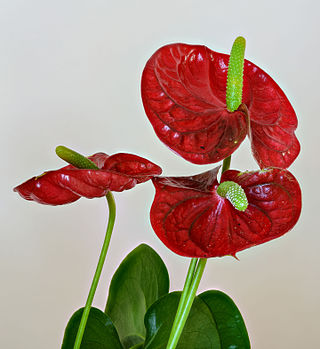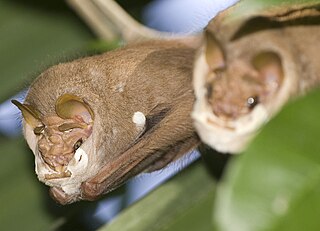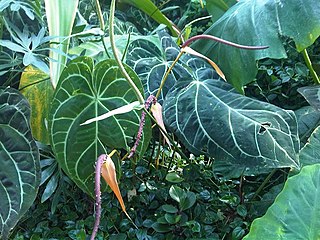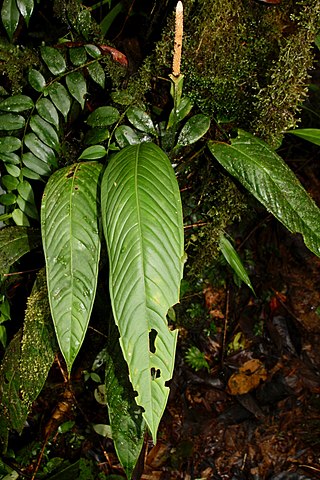
The Araceae are a family of monocotyledonous flowering plants in which flowers are borne on a type of inflorescence called a spadix. The spadix is usually accompanied by, and sometimes partially enclosed in, a spathe. Also known as the arum family, members are often colloquially known as aroids. This family of 114 genera and about 3,750 known species is most diverse in the New World tropics, although also distributed in the Old World tropics and northern temperate regions.

In botany, a bract is a modified or specialized leaf, especially one associated with a reproductive structure such as a flower, inflorescence axis, or cone scale.

Anthurium is a genus of about 1,000 species of flowering plants, the largest genus of the arum family, Araceae. General common names include anthurium, tailflower, flamingo flower, pigtail plant, and laceleaf.

Spathiphyllum is a genus of about 47 species of monocotyledonous flowering plants in the family Araceae, native to tropical regions of the Americas and southeastern Asia. Certain species of Spathiphyllum are commonly known as spath or peace lilies.

The Toltec fruit-eating bat is a species of bat in the family Phyllostomidae. It is also sometimes called the "lowland fruit eating bat."

The wrinkle-faced bat is a species of bat in the family Phyllostomidae and the only identified member of the genus Centurio. This bat is found in various countries in and around Central America. It eats fruit but is not classified within the fruit bats, and is instead classified as a leaf-nosed bat even though it does not have a leaf nose. It has an unusually shaped skull which is thought to allow it to eat a wider range of foods than other bats.

Anthurium andraeanum is a flowering plant species in the family Araceae that is native to Colombia and Ecuador. It is a winner of the Royal Horticultural Society's Award of Garden Merit.
Petrocardium is an extinct genus of monocot plants in the family Araceae. At present it contains only two species Petrocardium cerrejonense and Petrocardium wayuuorum, the type species. The genus is solely known from the Middle to Late Paleocene, Cerrejón Formation deposits in Colombia.

Anthurium crystallinum is a species of flowering plant in the family Araceae, native to rainforest margins in Central and South America, from Panamá to Perú. Growing to around 90 cm (35 in) tall and wide, A. crystallinum is an epiphytic perennial evergreen, known for its dark green and velvety-textured, heart-shaped leaves featuring prominent white veining, and somewhat resembles a smaller version of Anthurium magnificum. The inflorescence is a somewhat visually-nondescript spathe with a pale green spadix, appearing throughout the year.

Anthurium clarinervium is a species of flowering plant is in the family Araceae native to Chiapas, Mexico. The Anthurium genus is known to contain approximately 1,000 species, resulting in one of the most diverse Central American tropical plant genera.

Anthurium acaule is a herbaceous plant in the family Araceae. It is endemic to Martinique. The plant has a complicated taxonomic history, and the name Anthurium acaule has been applied to several other plants.

Anthurium warocqueanum, commonly known as the Queen Anthurium, is a species of plant in the genus Anthurium. Native to Colombia, it is grown in more temperate climates as a greenhouse specimen or houseplant for its ornamental foliage.

Anthurium pedatoradiatum or Anthurium Fingers is a species of plant in the genus Anthurium native to southern Mexico. A. pedatoradiatum has leaves with deep finger-like sections, and is terrestrial. Its natural habitat is from sea level up to 1,000 meters (3,300 ft) in the Mexican states of Veracruz, Tabasco, and Chiapas. It is related to other Anthurium in the section Schizoplacium such as Anthurium podophyllum, and its species name in Latin refers to the radiating growth of its palm-like leaves.
Thomas Bernard Croat is an American botanist and plant collector, noteworthy as one of botanical history's "most prolific plant collectors". He has collected and described numerous species of plants, particularly in the family Araceae, in his career at the Missouri Botanical Garden.

Philodendron giganteum is a species of plant in the Araceae family. It is found in the Caribbean and South America. Heinrich Wilhelm Schott first described it in 1856. P. giganteum inflorescences are thermogenetic and emit a sweet odor. In the English-speaking Caribbean, this plant may be called Elephant Ear or Chinny Leaf.

Anthurium regale is a species of Anthurium, a genus of flowering aroid plant in the family Araceae. It was first described by Europeans in the 1866 edition of La Belgique Horticole, where it was noted to be first collected for the houseplant trade by Gustav Wallis during his time working for Jean Jules Linden. This impressive and sought-after Anthurium species is native to Perú, where it may be found near the Huallaga River valley, to the north of Tingo María and Juanjuí, in the regions of Huánuco and San Martín, respectively. This species is found in forested areas, where it grows on trees epiphytically, ranging from sea-level environments to cloud forests, up to about 243 meters in elevation. A. regale is often found in areas where the ambient humidity is consistently high, and where temperatures remain steadily between 15 °C (59°F) and 26.6 °C (80°F).

Anthurium podophyllum is a species of plant in the genus Anthurium native to coastal areas of the Mexican states of Veracruz and Oaxaca. A terrestrial species, it grows in tropical forest understories in seasonally dry areas. It is named for its palmate leaves that somewhat resemble plants in the (unrelated) genus Podophyllum, and which have many subdivisions. It is related to other terrestrial Anthurium with similar leaf morphology in the section Schizoplacium, such as Anthurium pedoradiatum, and produces orange berries.

Anthurium jenmanii is a species of plant in the genus Anthurium. Growing as an epiphyte subshrub, it is native to South America from Trinidad and Tobago to Brazil. A member of the section Pachyneurium, and like related species it has a "birds nest" growth habit. It has a dark purple-black spadix and spathe, and produces red berries. In cultivation, it is commonly mistaken for Anthurium bonplandii subsp. guayanum, a related species.

Anthurium pallens is a species of plant in the genus Anthurium. Growing as a climbing epiphyte with short stems and usually pendent growth, it is native to Central America. Easily confused with other species such as Anthurium microspadix, it can be distinguished by its typically shorter branches and leaf blades acute to rounded at the base.

Anthurium coloradense is a species of plant in the genus Anthurium native to Panama. A member of the section Polyneurium, this terrestrial shrub is most recognizable by its thin, veined leaves and its yellow-green spadix. Its foliage is very similar to other Panamanian species such as Anthurium caperatum, Anthurium santamariae and Anthurium cerrosantiagoense but may be distinguished by details such as the grooves in its stems and the pattern of veining, with the collective vein growing from the third vein in a leaf.
















